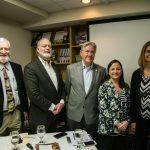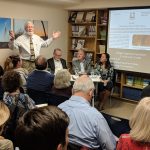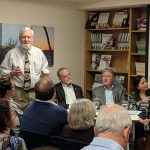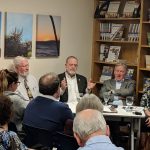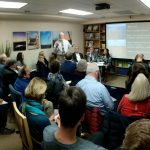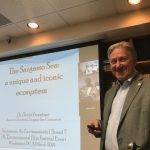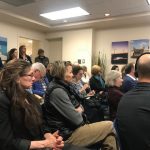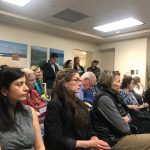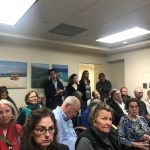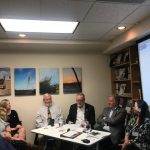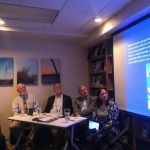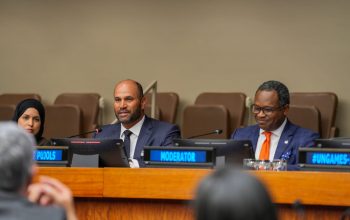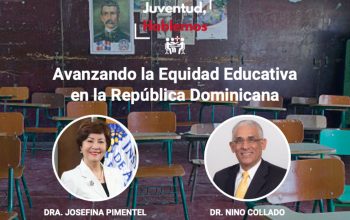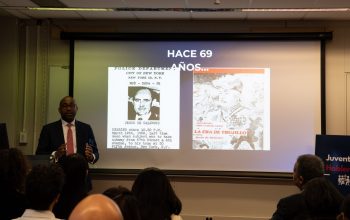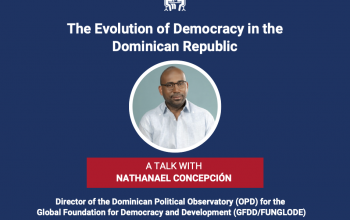news
Sargassum: Both an Environmental Economic Opportunity and a Challenge
March 19, 2019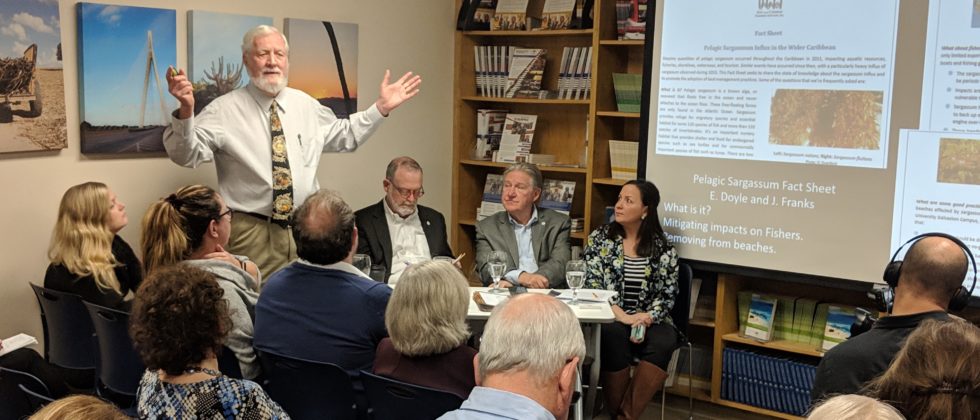
In the context of a continuous collaboration with the Environmental Film Festival at the Nation’s Capital (DCEFF), GFDD, together with its Dominican Republic Environmental Film Festival (DREFF) hosted a panel discussion titled “Sargassum: An Environmental Threat?” at its Washington, DC offices. The initiative was part of the 2019 official program of DCEFF.
Maria Victoria Abreu, GFDD’s International Affairs and Socioeconomic Development Program Manager and DREFF’s Programming Director, gave the welcoming remarks, introduced the international experts and moderated the discussion. Panelists included Dr. Donald R. Johnson, Senior Research Scientist from the Gulf Coast Research Laboratory, and a Retired Physical Oceanographer from the Naval Research Laboratory, Stennis Space Center; Dr. Chuanmin Hu, Ph.D. in Physics, Author, and an Expert on Optical Oceanography from the University of South Florida (USF) College of Marine Science, whose research focuses on addressing coastal ocean problems using primarily optics; Manolo Despradel, General Manager, Algeanova (Dominican Republic); Michel Kaine, from Grogenics SB Inc., working with Algeanova with the transformation of sargassum; Dr. David Freestone, Executive Secretary of the Sargasso Sea Commission and founder and Editor-in-Chief of the International Journal of Marine and Coastal Law; and Mark J. Spalding, President of The Ocean Foundation, member of the Ocean Studies Board of the National Academies of Sciences, Engineering, and Medicine, and Senior Fellow at the Center for the Blue Economy, at the Middlebury Institute of International Studies.
Dr. Johnson explained the coverage and depth of sargassum in the Caribbean and West African coast and said “There is no smoking gun. If you push the climate over to this point it will have a serious impact on fishing but if you push it back to where it was, it won’t fix anything.” He also noted the negative impacts of sargassum reaching shorelines, including reduced tourism and some human health consequences. On shore ecology, he said that it will likely impact turtle nesting.
Talking about satellite observations of sargassum, Dr. Hu showed the “red edge” reflectance and explained how he was able to map the sargassum. He showed how most sargassum is in the Gulf of Mexico and the Caribbean coast of South America. Hu also explained that there is significant change in monthly mean coverage of sargassum and said that “what causes this variation? We simply do not know.” He showed a two-year cycle of how the sargassum varies in the Caribbean Sea. “Based on this we can build a predictive model of when large coverage of sargassum will appear”, said Dr. Hu.
Using some videos and photos, Manolo Despradel showed some special nets that have been designed for capturing sargassum at the Puntacana beaches in the Dominican Republic by his company AlgeaNova. He explained the special machine developed, already collecting 3 tons of sargassum every day. “Very soon 300 tons of sargassum will be collected daily by these machines,” said Despradel. Michel Kaine further explained the products developed by the same company, AlgeaNova and highlighted that there are some ways that sargassum can be very economically valuable beyond saving tourism. He mentioned for instance that there is a big movement to produce more organic crops, but companies have a hard time getting organic fertilize -sargassum can act as one of these fertilizers.
“Biogas from sargassum is another source of economic potential for the residue. It may potentially be used as a bio fuel. This is something the company will investigate”, noted Kaine.
Dr. Freestone provided the perspective of the Sargasso Sea Project, which was led by the Government of Bermuda and now include several other nations. Part of the project was investigating the legal frameworks related to the Sargassum Sea, but also identifying the benefits of sargassum. He showed the endemic species that actually live within the Sargasso Sea. Sea turtles, for instance, spend time in the sargassum which provides them food and habitat, he explained. European Eels, a major source of export for China, breed in the Sargasso Sea.
“It’s an amazingly important system” said Dr. Freestone about the Sargasso Sea. “Location, location, location”. If we are talking about the Sargasso Sea, it’s a golden ecosystem; if we are talking about sargassum in the shores, we can understand how it affects tourism and other areas.
Mark Spalding was last to speak. “We need to put this in context. The ocean is changing. It is filled with plastics. We are not just seeing macro algae influences. We are also seeing micro algae impacting tourism in many places.” “If you allow sargassum to stay on the beach it can help to build up beach stability which prepares it for the next hurricane,” he said, stressing another benefit of Sargassum. “If we remove everything for the intent of saving tourism we may make some mistakes,” mentioned Spalding.
After the presentation, speakers engaged in a very interesting conversation with the audience and answer several questions.
Videos:
Sargassum Collection by Algeanova – 01
Sargassum Collection by Algeanova – 02
Sargassum Collection by Algeanova – 03
Sargassum Collection by Algeanova – 04
Presentations:
- The Sargasso Sea: a unique and iconic ecosystem
by Dr. David Freestone - Sargassum in the ocean, Where, when, why – observations from satellites
by Chuanmin Hu - Holopelagic Sargassum
by D. Johnson
More information:
https://www.oceanfdn.org/blog/sargassum-sum
https://www.oceanfdn.org/resources/sargasso-sea
http://www.sargassoseacommission.org/about-the-sargasso-sea
http://www.algeanova.com/en/

